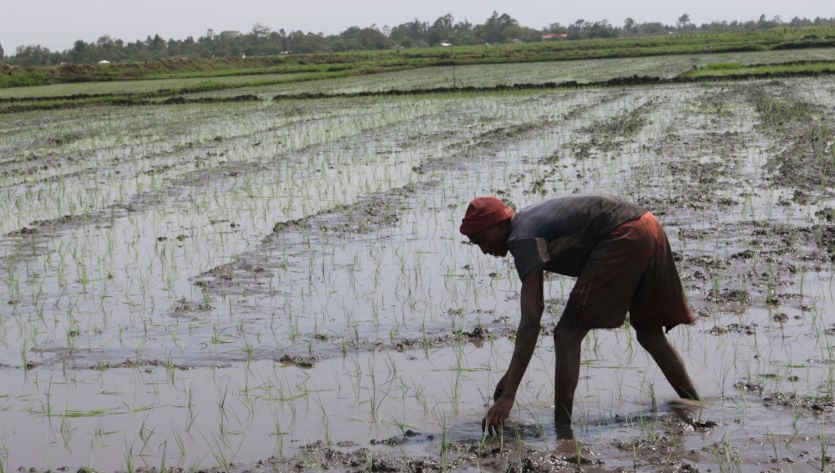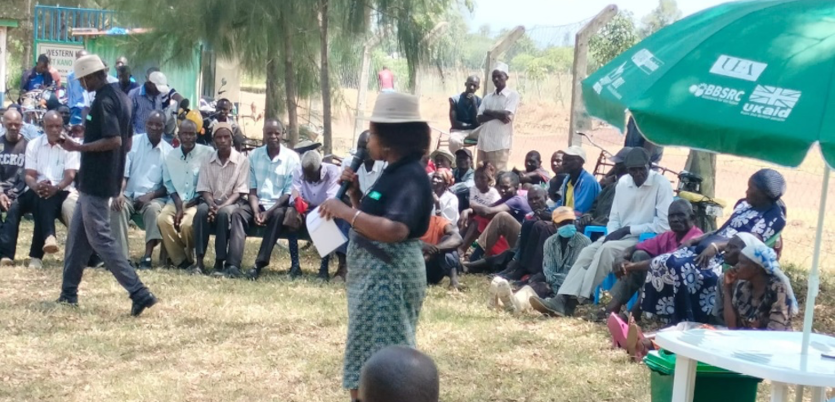This article is supported by https://www.cabi.org/”>CABI
[NAIROBI] When Kenyan rice farmer Andrew Wangura was preparing for planting, he noticed unusual fruit – “some strawberries” – on plants growing in his irrigation channels. A few days later, his neighbour Susan Njane and other farmers reported similar odd experiences.Wangura and Njane did not know that what seemed like pink berries were masses of eggs of a pest with the potential to ravage their rice fields in Mwea, Central Kenya. Wangura saw cases of children feeding on the eggs and developing stomach complications.
“We did not know what this was actually … after some time, the numbers increased … they were all over,” he recalls.
That was in May 2019. During the main planting season the following April, about ten farmers based near the local irrigation scheme’s main water feeder transplanted their rice from the nursery beds to the farms. “When we woke up the following day, the paddy fields were clear … there was nothing,” remembers Wangura, who was the local leader in the area’s irrigation project.
“With the absence of effective natural enemies in Africa, porous borders, and weak domestic quarantine measures, it means that [apple snail] can reproduce and multiply at high rates…nothing can stop it.”
Fernadis Makale, CABI research scientist
In panic, the farmers reported to the authorities, who began investigating.
“We became vigilant and noticed snails in the farms feeding on the young rice plants. We started handpicking and burning them,” says Njane. No pesticide seemed effective.
The golden apple snail can lay as many as 3,000 reddish-pink eggs overnight on any surface above water level. Copyright: Credit: F. Makale / CABI.
“In fact, they were increasing in numbers and feeding on our rice. There were too many, getting us overwhelmed. You can’t see them easily, as they stay under water during the day and attack the farms at night,” says Wangura.
In 2020, scientists from the Kenya Plant Health Inspectorate Service and the Centre for Agriculture and Bioscience International (https://www.cabi.org/”>CABI, the https://www.scidev.net/global/content/about-us.html”>parent organisation of SciDev.Net) conducted a study that confirmed the presence of the dark brown golden apple snail, known by scientists as Pomacea canaliculate, in the Mwea irrigation scheme, which produces 70 per cent of the country’s rice. The snail is listed among the top 100 most damaging invasive species by the International Union for Conservation of Nature.
https://www.scidev.net/global/content/plus.html”>
“This is the first and only report [of apple snail] in Africa. We immediately embarked on a delimiting survey to establish the extent of snails’ spread in the scheme so as to guide mitigation and management efforts,” says CABI research scientist Fernadis Makale. Five rice schemes in Central and Western Kenya were targeted by the survey.
The pest thrives in waterways and irrigation systems and feeds on young, vulnerable rice seedlings in the nursery beds, or immediately after transplantation to the paddy fields.
“One adult can feed on one square metre of rice in one night,” says Makale.
He says that when they are not feeding, they are mating and that the female can lay 3,000 reddish-pink eggs overnight on any surface above water level, which turn white when about to hatch.
‘Huge economic losses’
Vincent Koskei, a research officer from Kenya’s National Irrigation Authority based in Mwea, says the pest had infested 11 per cent of the 30,600-acre scheme, which is valued at KES15 billion (US$123 million) and covers the paddy fields of more than 11,000 farmers.
“The pest can cause huge economic losses if not well managed because it feeds on young and emerging rice plants, forcing farmers to do repetitive transplantations,” warns Koskei. “The farmers have tried to live with it, but it’s not easy.

A farmer working in a rice paddy in the Mwea irrigation scheme which produces 70 per cent of Kenya’s rice. Credit: F. Makale / CABI.
“If effective management strategies are not put in place, things could worsen by next year.”
Some farmers, he says, are now reporting up to four re-transplantations, which is extremely costly for them. Koskei estimates that one acre of paddy field could cost a farmer about US$250 just for transplantation labour costs, on to which must be added the expense of nursery management and purchase of seeds.
“In the 2020 season, I was forced to transplant thrice, costing me a lot of money and time,” says Wangura. Njane estimates that she spent US$600 more in the 2020 season on re-transplantation than in previous years.
“You can imagine how much farmers incur when they have to do several transplantations in one season,” said Koskei. “The farmers are so desperate.
“They are currently using pesticides not listed by the pest control unit to spray their farms … they are not registered for management of the golden apple snail.”
The use of unapproved pesticides to manage the snail, Koskei points out, poses health and environmental concerns as the irrigation water is used for domestic purposes in some homes.
“The snail has become a serious agricultural and ecological pest in the scheme due to their enormous reproduction ability and high survival rates,” adds Makale.
Although the golden apple snail primarily feeds on rice stems, it has a wide appetite, including arrowroot, pawpaw, cabbage, bananas, and grass. The hatched snails have a 90 per cent survival rate and can live for at least four years, according to the CABI researchers.
Damage mitigation
As scientists search for a biopesticide – a biological substance or organism that tackles plant pests – Koskei says farmers are currently advised to withdraw water immediately from the rice fields after irrigation as wetting and drying is “the most effective strategy” to keep the paddy field moist and discourage the snails.
“We are now learning to live with this snail,” said Wangura. “When we are preparing our farms for planting, we do levelling and drain water immediately after transplanting for four to five days as they don’t like to walk where the land is moist.”

Agronomists conduct a plant health rally in Western Kenya to raise awareness about the golden apple snail as part of CABI’s PlantwisePlus programme. Credit: F. Makale / CABI.
Njane and Wangura say that this system made their farms safe from the pest after three weeks, when the snail could no longer feed on the rice.
Although the snail is currently reported only in Mwea, scientists warn that its spread to other irrigation schemes could be imminent.
“Dispersal from Mwea to Western Kenya could just be a matter of when, and that is why we want to educate farmers to prevent spread,” says Makale.
At the start of this month, CABI and Kenya’s Ministry of Agriculture held a capacity building workshop for agronomists from Kenya’s rice farming regions. The agronomists then embarked on plant health rallies in Ahero and Kano irrigation schemes in Western Kenya to raise awareness about the snail as part of CABI’s PlantwisePlus programme. The programme aims to help countries predict, prevent and prepare for plant health threats to reduce crop losses.
The agronomists educated farmers on how to identify the pest and interventions to prevent spread, such as field hygiene to combat egg-laying. The farmers were also urged to ensure sanitization of machines such as combine harvesters coming from infested areas.
https://scidevnet.enthuse.com/scidevdonation#!/?utm_source=int_website&utm_medium=link&utm_campaign=global%20two&utm_term=mar21&utm_content=scidev_12″>
“Sensitising all the value chain actors could delay or limit the spread of this pest in the country,” says Teresia Karanja, deputy director of plant protection and food safety directorate under the Ministry of Agriculture’s department for crops development and agricultural research in Kenya.
“We need to safeguard not only Kenya but the region and Africa at large.”
Karanja calls on the government to raise the red flag and “save the continent”, especially rice-producing countries such as Nigeria. She also calls for enhanced national and regional research partnerships, surveillance, and early-warning systems to control the spread of the species.
According to experts at the workshop, the golden apple snail spreads through the aquarium trade, sharing of farm machinery such as combine harvesters, or by water birds carrying the young snails and eggs from one point to another. In Taiwan, the golden apple snail was introduced to control weeds, while other countries, including Japan and The Philippines, introduced it as a source of protein.
The scientists have called for well-coordinated national and regional research partnerships as the search for a biopesticide gets underway. They warn that without effective control, the pest could spread and become a “serious continental problem”.
“With the absence of effective natural enemies in Africa, porous borders, and weak domestic quarantine measures, it means that it can reproduce and multiply at high rates … nothing can stop it,” says Makale.
This piece was produced by SciDev.Net’s Global desk.
This article is supported by https://www.cabi.org/”>CABI. https://www.plantwise.org/”>PlantwisePlus is a CABI-led global programme to help countries predict, prevent and prepare themselves for plant health threats – thereby ensuring farmers reduce their crop losses and produce the quantity of food required and also to improve the quality of food grown, in the face of a changing climate.
https://www.scidev.net/global/features/rice-eating-apple-snail-wreaks-havoc-in-kenya/”>
